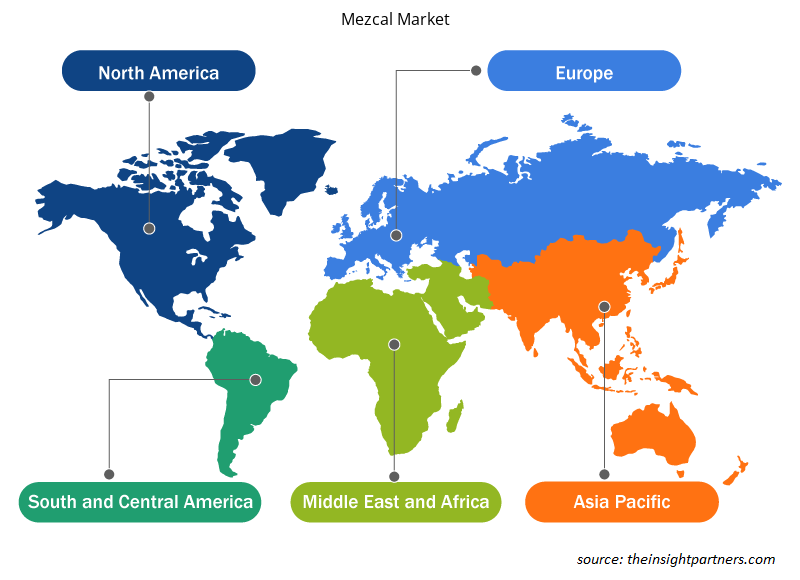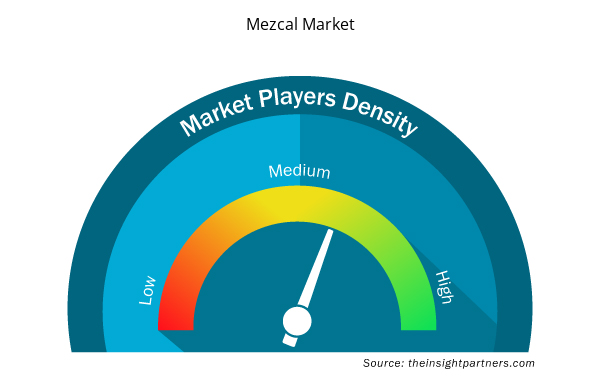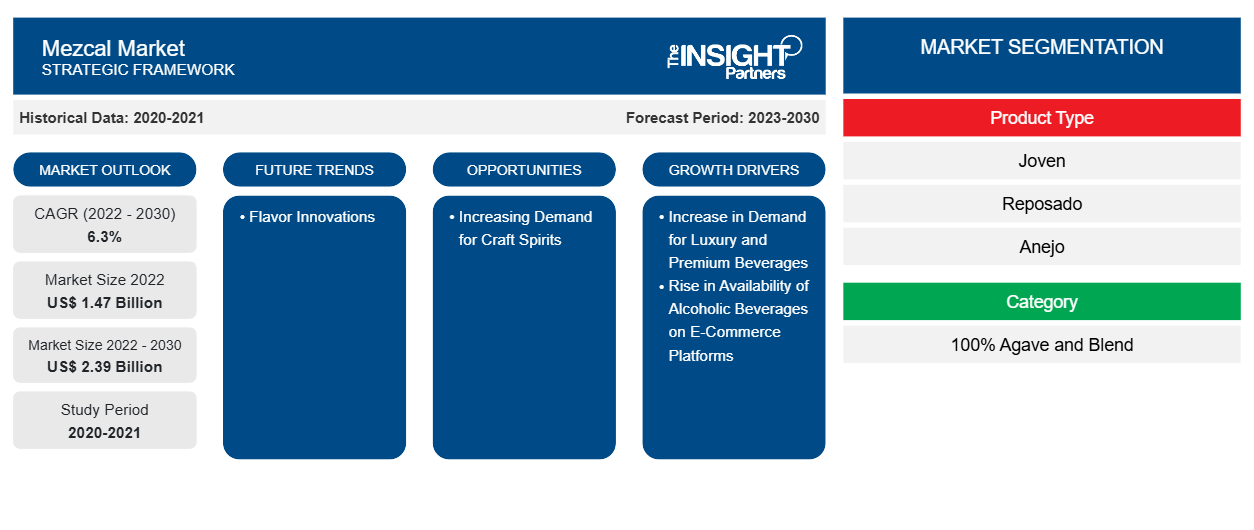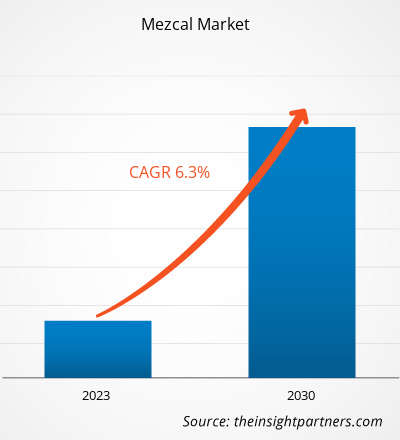[研究报告] 2022 年梅斯卡尔酒市场规模价值 14.6917 亿美元,预计到 2030 年将达到 23.9357 亿美元;预计 2022 年至 2030 年的复合年增长率为 6.3%。
市场洞察和分析师观点:
梅斯卡尔酒是一种独特的墨西哥烈酒,由龙舌兰植物制成,主要产于瓦哈卡地区。与仅由蓝色龙舌兰制成的龙舌兰酒不同,梅斯卡尔酒可以用各种龙舌兰品种酿造,因此其风味和香气更加丰富。梅斯卡尔酒需求的激增可以归因于其手工制作的方法、独特的烟熏味道以及人们对手工烈酒日益增长的欣赏。消费者越来越追求饮酒体验的真实性和多样性,这使得梅斯卡尔酒在喜欢冒险的烈酒爱好者和调酒师中越来越受欢迎。它的文化遗产和传统的生产技术也增加了它的吸引力,使其成为那些希望探索龙舌兰烈酒丰富世界的人们的抢手选择。
增长动力和挑战:
对奢侈和优质饮料的需求不断增长,已成为梅斯卡尔酒市场的驱动力。这一趋势的一个重要催化剂是消费者可支配收入的增加。随着人们收入的增长,他们更倾向于将一部分预算用于享受梅斯卡尔酒等高端烈酒。这为高端梅斯卡尔酒品牌的蓬勃发展提供了机会,因为消费者寻求独特、高级的饮酒体验。此外,千禧一代的影响力不容小觑。这一人口群体表现出对高端饮料的特别偏好,其驱动力是追求质量、真实性和独特风味。梅斯卡尔酒完全符合这些偏好,提供与千禧一代人口产生共鸣的手工制作和工艺产品,大大促进了需求的激增。
定制此报告以满足您的需求
您可以免费定制任何报告,包括本报告的部分内容、国家级分析、Excel 数据包,以及为初创企业和大学提供优惠和折扣
- 获取此报告的关键市场趋势。这个免费样品将包括数据分析,从市场趋势到估计和预测。
此外,消费者偏好的演变在推动梅斯卡尔酒市场方面发挥着关键作用。现代消费者越来越寻求超越普通的独特而精致的烈酒。梅斯卡尔酒凭借其复杂的生产工艺、烟熏味和独特的风味,很好地适应了这种转变。它已成为精致品味的象征,并获得了优质饮料选择的声誉,吸引了寻求更高饮酒体验的挑剔消费者。
蓬勃发展的鸡尾酒文化进一步推动了梅斯卡尔酒在奢侈饮料市场的崛起。调酒师和调酒师已经将梅斯卡尔酒视为制作独特创新鸡尾酒的多功能优质原料。其烟熏和复杂的风味为饮料增添了深度和个性,使其成为高档酒吧和餐厅的抢手之选。这提高了梅斯卡尔酒的知名度,并激发了消费者在家中重现这些高档鸡尾酒体验的兴趣,进一步推动了需求。
最后,有效的营销策略和独特的包装进一步增强了人们对梅斯卡尔酒作为奢侈品的认知。高端梅斯卡尔酒品牌投资打造了精致的品牌形象,突出了产品的手工来源,强调了其独特性。这种营销方式吸引了那些寻求地位象征和独特礼品选择的消费者,从而增强了梅斯卡尔酒在高端烈酒市场的需求。
然而,墨西哥对梅斯卡尔酒的生产、标签和认证有着严格的规定。梅斯卡尔酒原产地名称保护了梅斯卡尔酒的地理来源和传统生产方法,它制定了一系列规则,这些规则可能会给生产商带来负担。例如,要贴上“梅斯卡尔酒”的标签,烈酒必须由特定品种的龙舌兰植物制成,这些植物主要分布在墨西哥的某些地区,并且采用传统方法生产。传统方法包括在土坑或粘土炉中烹饪、手工研磨、在石坑或有机坑中发酵,以及在铜罐或陶罐下用直火蒸馏。满足这些要求可能成本高昂或耗时,从而限制了小型生产商进入市场并有效竞争的能力。
另一个监管挑战与认证和标签有关。生产商必须遵守严格的质量标准并经过认证程序才能贴上官方的“梅斯卡尔”标签。这对规模较小的本地生产商来说可能是一个障碍,因为他们可能没有资源来完成这些官僚程序或投资必要的设备和设施。此外,关于标签和广告的严格规定包括指定使用的龙舌兰类型、生产地区和蒸馏过程。任何偏离这些规则的行为都可能导致法律问题,因此生产商必须严格遵守规定。这些监管限制可能会限制市场进入、阻碍创新并产生合规成本,尤其是对于小型梅斯卡尔生产商而言。
报告细分和范围:
全球梅斯卡尔酒市场 根据产品类型、类别、分销渠道和地理位置进行细分。根据产品类型,市场分为 Joven、Reposado、Anejo 和其他。根据类别,市场分为 100% 龙舌兰和混合。根据分销渠道,市场分为超市和大卖场、专卖店、在线零售和其他。根据地理位置,全球梅斯卡尔酒市场大致分为北美、欧洲、亚太地区、中东和非洲以及南美和中美洲。
节段分析:
根据产品类型,市场分为 joven、reposado、anejo 和其他。reposado 部分预计将在 2022-2030 年期间实现最高的复合年增长率。Reposado 在西班牙语中意为“休息”,代表了 joven 的年轻大胆和 anejo 梅斯卡尔的陈年复杂性之间的中间地带。它在橡木桶中经历了相对较短的陈化过程,为两个月到一年。这种陈化赋予了烈酒更醇厚的特性,抚平了龙舌兰的一些尖锐边缘。在保留核心龙舌兰风味的同时,reposado 梅斯卡尔还产生了额外的细微差别,例如淡淡的香草、焦糖和木材味。它的需求激增是因为它能够平衡 joven 未陈化的活力和 anejo 精致的复杂性,使其成为那些寻求更顺滑、更平易近人的梅斯卡尔体验的人的首选。
区域分析:
梅斯卡尔酒市场分为五个主要区域:北美、欧洲、亚太地区、南美和中美以及中东和非洲。北美主导着全球梅斯卡尔酒市场,2022 年该地区市场规模为 6.122 亿美元。欧洲是第二大贡献者,占全球市场份额的 29% 以上。预计亚太地区在 2022-2030 年期间的复合年增长率将超过 7%。梅斯卡尔酒在亚洲国家(如中国、印度、日本和澳大利亚)的消费者中越来越受欢迎。消费者转向梅斯卡尔酒主要归因于日益增长的健康问题。人们对奢侈酒精饮料的偏好日益增加,增加了对梅斯卡尔酒的需求,预计这将推动亚太地区的市场增长。
梅斯卡尔市场区域洞察
Insight Partners 的分析师已详细解释了预测期内影响梅斯卡尔酒市场的区域趋势和因素。本节还讨论了北美、欧洲、亚太地区、中东和非洲以及南美和中美洲的梅斯卡尔酒市场细分和地理位置。

- 获取梅斯卡尔市场的区域特定数据
梅斯卡尔市场报告范围
| 报告属性 | 细节 |
|---|---|
| 2022 年市场规模 | 14.7亿美元 |
| 2030 年的市场规模 | 23.9亿美元 |
| 全球复合年增长率(2022 - 2030 年) | 6.3% |
| 史料 | 2020-2021 |
| 预测期 | 2023-2030 |
| 涵盖的领域 | 按产品类型
|
| 覆盖地区和国家 | 北美
|
| 市场领导者和主要公司简介 |
|
梅斯卡尔酒市场参与者密度:了解其对商业动态的影响
梅斯卡尔酒市场正在快速增长,这得益于终端用户需求的不断增长,而这些需求又源于消费者偏好的不断变化、技术进步以及对产品优势的认识不断提高等因素。随着需求的增加,企业正在扩大其产品范围,进行创新以满足消费者的需求,并利用新兴趋势,从而进一步推动市场增长。
市场参与者密度是指在特定市场或行业内运营的企业或公司的分布情况。它表明在给定市场空间中,相对于其规模或总市场价值,有多少竞争对手(市场参与者)存在。
在梅斯卡尔市场运营的主要公司有:
- 卡萨龙舌兰有限公司
- 基基里基梅斯卡尔酒有限公司
- 达维德·坎帕里·米兰NV
- 梅斯卡尔酒庄
- 百加得马天尼公司
免责声明:上面列出的公司没有按照任何特定顺序排列。

- 获取梅斯卡尔市场顶级关键参与者概览
COVID-19 疫情影响:
由于制造工厂关闭、劳动力短缺、供应链中断和金融不稳定,COVID-19 疫情最初阻碍了全球梅斯卡尔酒市场的发展。COVID-19 疫情导致经济放缓,各行各业受到干扰,从而限制了梅斯卡尔酒的供应。各种酒类商店都关门了。然而,随着各国放松先前实施的限制措施,企业开始发展壮大。此外,各国政府推出 COVID-19 疫苗缓解了局势,导致全球商业活动增加。在解除封锁和行动限制后,包括梅斯卡尔酒市场在内的多个市场均报告了增长。
竞争格局和重点公司:
Casa Agave Ltd、Quiquiriqui Mezcal Ltd、Davide Campari Milano NV、Gente de Mezcal SA de CV、Bacardi-Martini BV、Diageo Plc、Pernod Ricard SA、Memberly Drinks Ltd、Proximo Spirits Inc 和 Madre Mezcal Inc 是全球梅斯卡尔酒市场上的知名参与者。
- 历史分析(2 年)、基准年、预测(7 年)及复合年增长率
- PEST 和 SWOT 分析
- 市场规模价值/数量 - 全球、区域、国家
- 行业和竞争格局
- Excel 数据集



Report Coverage
Revenue forecast, Company Analysis, Industry landscape, Growth factors, and Trends

Segment Covered
This text is related
to segments covered.

Regional Scope
North America, Europe, Asia Pacific, Middle East & Africa, South & Central America

Country Scope
This text is related
to country scope.
常见问题
The major players operating in the global mezcal market are Casa Agave Ltd, Quiquiriqui Mezcal Ltd, Davide Campari Milano NV, Gente de Mezcal SA de CV, Bacardi-Martini BV, Diageo Plc, Pernod Ricard SA, Meanwhile Drinks Ltd, Proximo Spirits Inc, and Madre Mezcal Inc among others.
In 2022, North America region accounted for the largest share of the global mezcal market. The North American region comprises developed and developing economies such as the U.S. and Canada, and Mexico. Several mezcal breweries have a strong foothold in the North American region. Key market players in the North American mezcal market include E.L. Silencio Holdings, Inc., Mezcal Vago, Ilegal Mezcal, Rey Campero, and many others. These breweries are constantly working towards innovation and developing different varieties of mezcal with improved tastes and qualities to attract new consumers and widen the consumer base in the region. The export of mezcal to several countries across North America will contribute to the rise in demand for mezcal in the region. Innovative programs aimed at marketing the product across North America will increase demand for mezcal in North America.
The rising demand for luxury and premium beverages has emerged as a driving force for the Mezcal market. One significant catalyst for this trend is the increase in the disposable income of consumers. As people's earnings have grown, they are more inclined to allocate a portion of their budget to indulging in high-end spirits such as Mezcal. This has opened up opportunities for premium Mezcal brands to thrive as consumers seek distinctive, elevated drinking experiences. Additionally, the influence of millennials cannot be understated. This demographic cohort has shown a particular penchant for spending on high-end beverages, driven by a desire for quality, authenticity, and unique flavor profiles. Mezcal aligns perfectly with these preferences, offering a handcrafted and artisanal product that resonates with the millennial demographic, contributing significantly to the surge in demand. Moreover, the evolution of consumer preferences plays a pivotal role in driving the Mezcal market. Modern consumers increasingly seek unique and sophisticated spirits that go beyond the ordinary. With its intricate production process, smoky notes, and distinct flavors, Mezcal aligns well with this shift. It has become a symbol of refined taste and has gained a reputation as a premium beverage choice, attracting discerning consumers looking for a more elevated drinking experience.
Based on product type, the market is categorized into joven, reposado, anejo, and others. The reposado segment is expected to register the highest CAGR during 2022–2030. Reposado, which translates to "rested" in Spanish, represents a middle ground between the youthful boldness of joven and the aged complexity of anejo mezcal. It undergoes a relatively short aging process of two months to one year in oak barrels. This aging imparts a mellower character to the spirit, smoothing out some of the agave's sharper edges. While retaining the core agave flavors, reposado mezcal develops additional nuances, such as hints of vanilla, caramel, and wood. Its surging demand is due to its ability to balance the unaged vibrancy of joven and the refined complexity of anejo, making it a preferred choice for those seeking a smoother and more approachable mezcal experience.
Based on category, the mezcal market is segmented into 100% agave and blend. 100% agave category represents mezcal made exclusively from agave plants, with no other sugar sources added during fermentation or distillation. It embodies the traditional and authentic spirit of mezcal production, highlighting various agave species' unique flavors and characteristics. The demand for 100% agave mezcal has been steadily increasing due to consumer's growing appreciation for pure and unadulterated spirits. Discerning drinkers seek the true essence of mezcal, valuing the rich diversity of agave flavors and the dedication of mezcaleros in preserving centuries-old production methods. This category's surge in popularity can be attributed to a desire for transparency and authenticity in the mezcal market as consumers become more educated about the significance of 100% agave labeling.
Mezcal producers are increasingly experimenting with different agave varietals, aging methods, and flavor infusions, which cater to changing consumer preferences and provide unique selling points for their brands. One example of flavor innovation is the use of different agave varieties. While espadin agave is the most commonly used for Mezcal production, some producers explore lesser-known agave types such as tobala, tepextate, and arroqueno. Each agave variety brings its distinct flavor profile to the Mezcal, from earthy and vegetal to fruity and floral notes. This diversity allows consumers to explore various flavors within the Mezcal category, catering to various palate preferences.
Another avenue of innovation involves the aging process. Mezcal aging can occur in various containers, such as oak barrels, glass, or clay pots. Producers experiment with different aging periods and container types to impart unique flavors and aromas. For instance, extended aging in oak barrels can introduce hints of vanilla and caramel, enhancing the complexity of the final product. This approach mirrors the techniques often seen in the whiskey and wine industries, offering a bridge for consumers transitioning from those spirits to Mezcal.
Trends and growth analysis reports related to Food and Beverages : READ MORE..
The List of Companies - Mezcal Market
- Casa Agave Ltd
- Quiquiriqui Mezcal Ltd
- Davide Campari Milano NV
- Gente de Mezcal SA de CV
- Bacardi-Martini BV
- Diageo Plc
- Pernod Ricard SA
- Meanwhile Drinks Ltd
- Proximo Spirits Inc
- Madre Mezcal Inc
The Insight Partners performs research in 4 major stages: Data Collection & Secondary Research, Primary Research, Data Analysis and Data Triangulation & Final Review.
- Data Collection and Secondary Research:
As a market research and consulting firm operating from a decade, we have published and advised several client across the globe. First step for any study will start with an assessment of currently available data and insights from existing reports. Further, historical and current market information is collected from Investor Presentations, Annual Reports, SEC Filings, etc., and other information related to company’s performance and market positioning are gathered from Paid Databases (Factiva, Hoovers, and Reuters) and various other publications available in public domain.
Several associations trade associates, technical forums, institutes, societies and organization are accessed to gain technical as well as market related insights through their publications such as research papers, blogs and press releases related to the studies are referred to get cues about the market. Further, white papers, journals, magazines, and other news articles published in last 3 years are scrutinized and analyzed to understand the current market trends.
- Primary Research:
The primarily interview analysis comprise of data obtained from industry participants interview and answers to survey questions gathered by in-house primary team.
For primary research, interviews are conducted with industry experts/CEOs/Marketing Managers/VPs/Subject Matter Experts from both demand and supply side to get a 360-degree view of the market. The primary team conducts several interviews based on the complexity of the markets to understand the various market trends and dynamics which makes research more credible and precise.
A typical research interview fulfils the following functions:
- Provides first-hand information on the market size, market trends, growth trends, competitive landscape, and outlook
- Validates and strengthens in-house secondary research findings
- Develops the analysis team’s expertise and market understanding
Primary research involves email interactions and telephone interviews for each market, category, segment, and sub-segment across geographies. The participants who typically take part in such a process include, but are not limited to:
- Industry participants: VPs, business development managers, market intelligence managers and national sales managers
- Outside experts: Valuation experts, research analysts and key opinion leaders specializing in the electronics and semiconductor industry.
Below is the breakup of our primary respondents by company, designation, and region:

Once we receive the confirmation from primary research sources or primary respondents, we finalize the base year market estimation and forecast the data as per the macroeconomic and microeconomic factors assessed during data collection.
- Data Analysis:
Once data is validated through both secondary as well as primary respondents, we finalize the market estimations by hypothesis formulation and factor analysis at regional and country level.
- Macro-Economic Factor Analysis:
We analyse macroeconomic indicators such the gross domestic product (GDP), increase in the demand for goods and services across industries, technological advancement, regional economic growth, governmental policies, the influence of COVID-19, PEST analysis, and other aspects. This analysis aids in setting benchmarks for various nations/regions and approximating market splits. Additionally, the general trend of the aforementioned components aid in determining the market's development possibilities.
- Country Level Data:
Various factors that are especially aligned to the country are taken into account to determine the market size for a certain area and country, including the presence of vendors, such as headquarters and offices, the country's GDP, demand patterns, and industry growth. To comprehend the market dynamics for the nation, a number of growth variables, inhibitors, application areas, and current market trends are researched. The aforementioned elements aid in determining the country's overall market's growth potential.
- Company Profile:
The “Table of Contents” is formulated by listing and analyzing more than 25 - 30 companies operating in the market ecosystem across geographies. However, we profile only 10 companies as a standard practice in our syndicate reports. These 10 companies comprise leading, emerging, and regional players. Nonetheless, our analysis is not restricted to the 10 listed companies, we also analyze other companies present in the market to develop a holistic view and understand the prevailing trends. The “Company Profiles” section in the report covers key facts, business description, products & services, financial information, SWOT analysis, and key developments. The financial information presented is extracted from the annual reports and official documents of the publicly listed companies. Upon collecting the information for the sections of respective companies, we verify them via various primary sources and then compile the data in respective company profiles. The company level information helps us in deriving the base number as well as in forecasting the market size.
- Developing Base Number:
Aggregation of sales statistics (2020-2022) and macro-economic factor, and other secondary and primary research insights are utilized to arrive at base number and related market shares for 2022. The data gaps are identified in this step and relevant market data is analyzed, collected from paid primary interviews or databases. On finalizing the base year market size, forecasts are developed on the basis of macro-economic, industry and market growth factors and company level analysis.
- Data Triangulation and Final Review:
The market findings and base year market size calculations are validated from supply as well as demand side. Demand side validations are based on macro-economic factor analysis and benchmarks for respective regions and countries. In case of supply side validations, revenues of major companies are estimated (in case not available) based on industry benchmark, approximate number of employees, product portfolio, and primary interviews revenues are gathered. Further revenue from target product/service segment is assessed to avoid overshooting of market statistics. In case of heavy deviations between supply and demand side values, all thes steps are repeated to achieve synchronization.
We follow an iterative model, wherein we share our research findings with Subject Matter Experts (SME’s) and Key Opinion Leaders (KOLs) until consensus view of the market is not formulated – this model negates any drastic deviation in the opinions of experts. Only validated and universally acceptable research findings are quoted in our reports.
We have important check points that we use to validate our research findings – which we call – data triangulation, where we validate the information, we generate from secondary sources with primary interviews and then we re-validate with our internal data bases and Subject matter experts. This comprehensive model enables us to deliver high quality, reliable data in shortest possible time.


 获取此报告的免费样本
获取此报告的免费样本